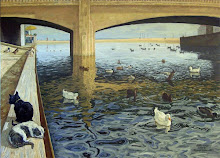Whenever Under Minerva Gallery has a featured show in the front of its space, the work of the artists currently working in Under Minerva’s Artists’ Den is also represented discretely in the recessed section of the space. These artists are Nicole Concepción, Matt Harvill, Jake Nelson, Vanessa Juriga, Tony Orrico, and Georgie Porgie. The several works that got my attention in the current offering are the following.
Untitled, 2009, by Vanessa Juriga, a canvas you might think of at first as a simple black on white composition. What gives this picture its magnetic pull is the tonal wallop the diagonally placed black delivers to the passive white field. Where black and white meet a great schism occurs, so far are the two tones from each other. Oriented from upper left to lower right, the black rectangle, with drawn hints of its being a solid, though not representationally so, disrespects the field by brusquely straying outside it’s borders. The line, of a different shade of black, at the left flank of the black shape, in a surprising move, traces a new trajectory, divergent from the object’s contour, taking your eye, at a vertiginous pace, further inside it.
Untitled, 2009, by Jake Nelson, is interesting as evidence of a performance. Executed from life, before an audience, it depicts a man playing a guitar in bold, black, very broad brush marks, over even broader washes of orange and white. In this piece, it’s not the “correctness” of drawing that matters, but the gall inherent in these devil-may -care strokes. This artist has something of the conceptual about him, a fact supported by his previous experience, described in his bio, as a “conceptual artist,” working in films and music videos in L. A., though that is a different type of conceptual -- and a more applied concept.
“Just Paper,” an oil painting, shows the more joking side of Mr. Nelson. Looking up from the surface of the floor at a man exercising the most private act of toilet sitting, you, dear viewer, might be a cockroach. From your vantage point, you see the objects commonly found on a bathroom floor: the toilet plunger, the cleaning brush, in its stand, the unclad sitter’s thigh, discreetly masked by the edge of the toilet seat, and a roll of toilet paper. In this case, one the segments of which are dollar bills. Whether the artist owned such a joke roll of toilet paper or invented it, the scornful take on the value of money is plain. Incidentally, the shadow cast by the sink on the bathroom wall shows some sensitive observation of reflected light.
“Damn You,” 2009, oil on wood, by Matt Harvill, consists of four square panels shown as a single piece, with space in the form of a cross between them (for which the artist has no symbolic intent, the title's reference to damnation not withstanding.) The four consist of red and black paint dripped beautifully on a white ground. Where red and black wet paint combined, a rich red-brown occurs.
Untitled, 2009, also by Matt Harvill, an oil in the 2 1/2’ range, very handsomely arrays stains of tan and blue, with may points of white occurring either from spatters of white, or pin-holing. Over this, thick black enamel stands in some relief, like so much tar. Jackson Pollock, in his grave, is probably enjoying this one.
This latter picture put me in mind of what happens when a very improvisatory saxophone player leaves evidence of his impromptu exercise in the form of a recording. Some listeners might be inclined to identify every nuance heard in the recording as “the way the piece really goes,” not realizing that in the next take of the same piece the performer may infuse it with an entirely new set of nuances. This analogy came to mind because of the difficulty a painter will have in controlling both the stains and the black drips that make up this little honey of a painting with absolute precision. I’m left with a product that seems quite right despite the elusiveness, or the improvisational, or accidental qualities, of this medium.
“Two Fish,” 2008, an Acrylic painting by Tony Orrico, is executed in this artist’s habitual mode: layer upon layer upon layer of color fields succeed one another, partially revealing the leavings of previous layers. Mr. Orrico then isolates the resulting shapes with a liner, which he terms his “favorite brush.” The large amount of black throughout the picture remains harmonious. The image this abstraction makes, as my own associations would have it, is of some forsaken patch of ground before an abandoned building with many banks of broken windows. On that ground, the bits of glass intermingle with all manner of debris. The artist told me that he liked that interpretation. I didn’t look for the “two fish.” Why so much devastation should be so gorgeous is a mystery.
“Afghan,” and “Quilt,” by Mr. Orrico, are similar to “Two Fish,” but with purer colors reminiscent of the pure, light filled colors visible on a projected animation film. In both cases, it was after the fact of execution that the artist saw the texture and colors relating to his grandmother’s, and his mother’s craft creations, respectively.
The current show at Under Minerva continues through May 24.
Under Minerva Gallery and Event Space
656 5th Ave., Brooklyn, NY 11215 (between 19th/20th St.)
Gallery Hours: Tuesdays-Fridays 12-6 P. M.. Saturdays 2-6 P. M..







No comments:
Post a Comment